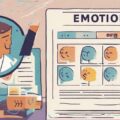Understanding the Emotion Wheel
The Emotion Wheel is a psychological tool that helps individuals identify and understand their emotions. Developed by psychologist Robert Plutchik, the wheel categorizes emotions into primary, secondary, and tertiary levels, offering a visual representation of how emotions are interconnected. This tool is beneficial for anyone looking to improve their emotional intelligence and manage their feelings effectively.
History and Origin
Robert Plutchik introduced the Emotion Wheel in 1980 as part of his psychoevolutionary theory of emotion. Plutchik’s model suggests that there are eight primary emotions: joy, trust, fear, surprise, sadness, anticipation, anger, and disgust. These emotions can combine to form more complex feelings, much like colors blend to create new shades.
Components of the Emotion Wheel
The Emotion Wheel is divided into several sections:
- Primary Emotions: The core emotions that form the foundation of the wheel.
- Secondary Emotions: Emotions that are blends of primary emotions.
- Tertiary Emotions: More nuanced emotions that stem from secondary emotions.
Each segment of the wheel represents a different emotion, with the intensity of the emotion decreasing as you move outward from the center.
Benefits of Using the Emotion Wheel
Using the Emotion Wheel offers several advantages:
- Enhanced Emotional Awareness: By identifying specific emotions, individuals can gain a better understanding of their feelings.
- Improved Communication: Knowing the precise emotions can help articulate feelings more clearly to others.
- Better Emotional Regulation: Recognizing emotions can aid in managing and regulating them effectively.
- Increased Empathy: Understanding one’s own emotions can enhance the ability to empathize with others.
How to Use the Emotion Wheel
Here are some practical steps to use the Emotion Wheel effectively:
- Identify the Emotion: Start at the center of the wheel and work outward to pinpoint the specific emotion you are experiencing.
- Reflect on the Emotion: Consider why you are feeling this way and what triggered the emotion.
- Express the Emotion: Use the identified emotion to communicate your feelings to others or to journal about it.
- Regulate the Emotion: Develop strategies to manage the emotion, whether through mindfulness, talking to a friend, or engaging in a hobby.
Common Misconceptions About the Emotion Wheel
There are some misconceptions about the Emotion Wheel that need to be addressed:
- It’s Only for Negative Emotions: The wheel includes both positive and negative emotions, helping to understand the full spectrum of feelings.
- It’s a One-Size-Fits-All Tool: While the wheel is a helpful guide, individual experiences with emotions can vary.
- It’s Only for Therapy: The Emotion Wheel is a versatile tool that can be used in everyday life, not just in therapeutic settings.
FAQ
What is the Emotion Wheel?
The Emotion Wheel is a visual tool created by psychologist Robert Plutchik to help identify and understand emotions. It categorizes emotions into primary, secondary, and tertiary levels.
How can the Emotion Wheel improve emotional intelligence?
By using the Emotion Wheel, individuals can enhance their emotional awareness, improve communication, regulate emotions better, and increase empathy.
Is the Emotion Wheel only for negative emotions?
No, the Emotion Wheel includes both positive and negative emotions, providing a comprehensive understanding of the emotional spectrum.
Can I use the Emotion Wheel outside of therapy?
Yes, the Emotion Wheel is a versatile tool that can be used in various contexts, including personal development, education, and everyday life.
How do I start using the Emotion Wheel?
Begin by identifying the emotion you are feeling, reflect on why you are feeling it, express the emotion, and then regulate it using appropriate strategies.









